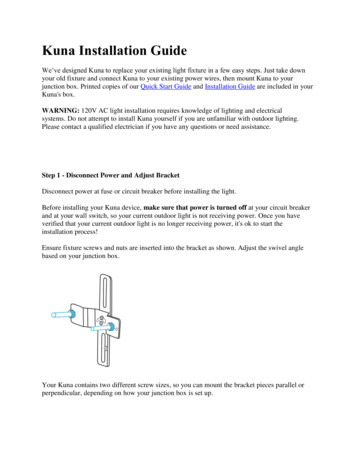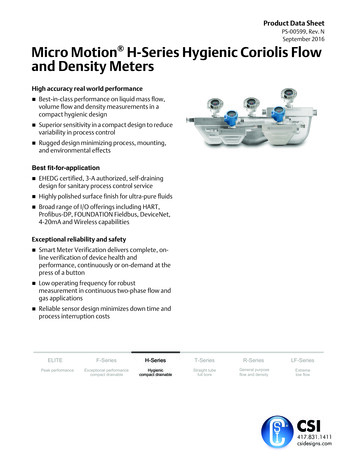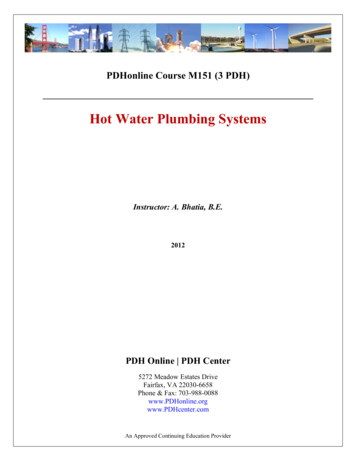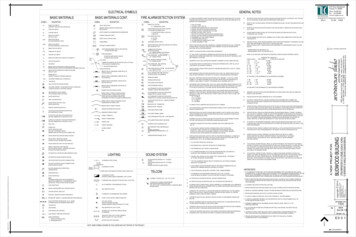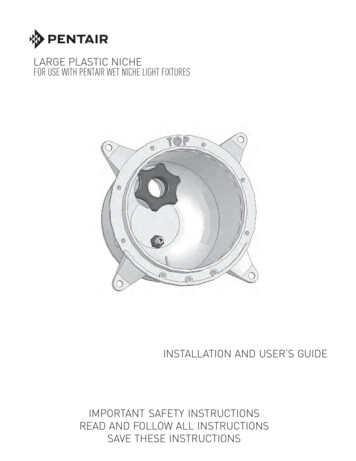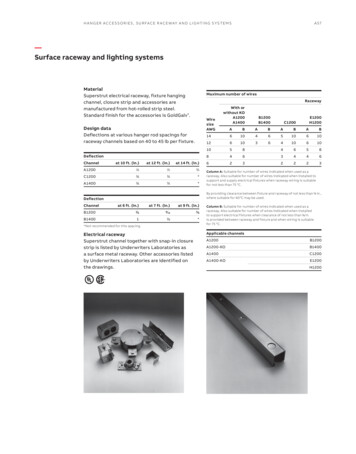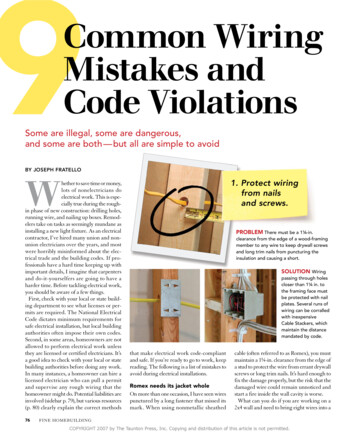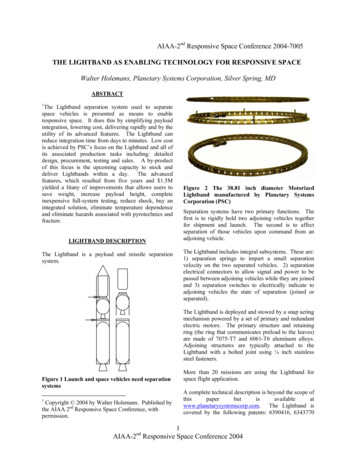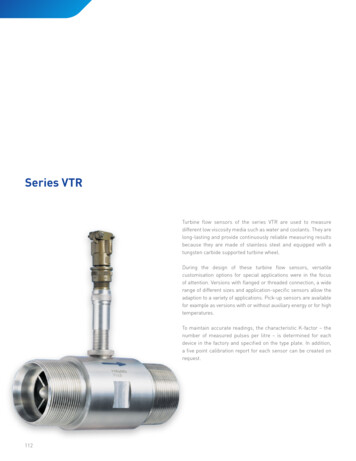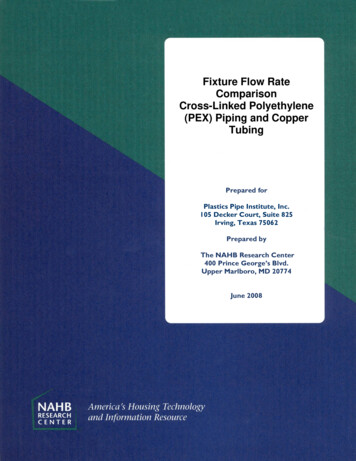
Transcription
Fixture Flow RateComparisonCross-Linked Polyethylene(PEX) Piping and CopperTubingPrepared forPlastics Pipe Institute, Inc.105 Decker Court, Suite 825Irving, Texas 75062Prepared byThe NAHB Research Center400 Prince George’s Blvd.Upper Marlboro, MD 20774June 2008
DisclaimerNeither the NAHB Research Center, Inc., nor any person acting on its behalf, makes anywarranty, express or implied, with respect to the use of any information, apparatus, method, orprocess disclosed in this publication or that such use may not infringe privately owned rights, orassumes any liabilities with respect to the use of, or for damages resulting from the use of, anyinformation, apparatus, method, or process disclosed in this publication, or is responsible forstatements made or opinions expressed by individual authors.
Fixture Flow Rate Comparison Cross-LinkedPolyethylene (PEX) Piping and Copper TubingTable of ContentsList of Tables.3List of Figures .3Executive Summary .5Background.5Test Setup – Copper Tubing.5Test Method .7Results and Discussion.7Conclusion .11List of TablesTable 1 – Pressure and Flow Test Set.7Table 2 – PEX 100-foot Flow Data .9Table 3 – Copper 100-foot Flow Data.10List of FiguresFigure 1 – 100' to Test Fixture .6Figure 2 – 60' to Test Fixture .6Figure 3 – Test Shower Valve. 7Figure 4 – Total System Flow at 40 PSI .8Figure 5 – Total System Flow at 60 PSI .8Figure 6 – Total System Flow at 80 PSI .9Figure 7 – Time to Hot Water.10NAHB Research CenterJune 2008Page 3 of 11
Fixture Flow Rate Comparison Cross-LinkedPolyethylene (PEX) Piping and Copper TubingNAHB Research CenterJune 2008Page 4 of 11
Fixture Flow Rate Comparison Cross-LinkedPolyethylene (PEX) Piping and Copper TubingExecutive SummaryIn a typical single-family residential plumbing system, PEX and copper piping systems willdeliver sufficient volumetric flow rates to the plumbing fixtures when using the same nominalsize tubing. While PEX tubing has a smaller inside diameter than copper tubing, both tubingsystems meet the farthest fixture demand, even with multiple fixtures flowing.Laboratory testing was performed on identical configurations for both PEX and copper trunk andbranch plumbing systems serving standard residential plumbing fixtures supplied at sourcepressures of 40, 60, and 80 psi for 60 and 100-feet of pipe to the furthest fixture. The flow rateof each plumbing fixture was virtually identical for both piping systems, except for minordifferences in the water closet flow rate.BackgroundIn 2006, the NAHB Research Center conducted flow and pressure tests on PEX tubing systemsconfigured as Trunk and Branch, Remote Manifold, and Home Run. 1 All of the PEX tubingsystems used metal insert fittings. System pressure and flow rates were measured during theoperation of actual household fixtures typically used in the residential market. A combination offixture operation, of up to five simultaneous fixture flows, provided a range of flow rates invarious sections of the piping system. One fixture, the primary Test Fixture, was monitoredduring each flow sequence. This Test Fixture was located the farthest from the source supply,both in distance and elevation. The flow rate and pressure at this fixture provided the basis foranalyzing the performance data of each system design and with multiple fixtures operatingsimultaneously. A similar test system and procedure was used to perform identical tests on asystem constructed with copper tubing and is reported here.Test Setup – Copper TubingBased on the previous testing of PEX plumbing systems, a Trunk and Branch system designwas constructed using Type M copper tubing and subjected to the same flow and pressure testregimen. The same test apparatus originally used for the PEX tubing tests was used toconstruct the copper system. The incoming water supply system, water heater, kitchen sinkfaucet, showerheads, lavatory faucet, and water closet were identical to the original PEX tests.The tub/shower valves were changed using the same brand/model, but only with differentrespective piping connections. The original test apparatus used ½” PEX barb connections.This test setup used ½” NPT threaded connections, as would be typical in actual practice. As inthe original PEX tests, the copper tests were performed on 100-foot and 60-foot systemsmeasured from the shutoff valves after the water heater to the furthest shower (Test Fixture).The test setup included a shower and kitchen sink located about 6 feet above the water supply,and a water closet, lavatory, and shower at about 15 feet above the water supply, as shown inFigures 1 and 2.1Residential PEX Water Supply Plumbing Systems: Design Guide, 2006. http://www.toolbase.org/pexdesignguide.NAHB Research CenterJune 2008Page 5 of 11
Fixture Flow Rate Comparison Cross-LinkedPolyethylene (PEX) Piping and Copper TubingFigure 1 – 100' to Test FixtureFigure 2 – 60' to Test FixtureNAHB Research CenterJune 2008Page 6 of 11
Fixture Flow Rate Comparison Cross-LinkedPolyethylene (PEX) Piping and Copper TubingThe copper tubing layouts above were modified only to replacethe sweep PEX 90 degree bends with 90 degree fittings. Inthe original 100-foot PEX setup, four of the seven 90 degreebends were metal insert fittings. In the 60-foot PEX setup, twoof the five 90 degree bends were metal insert fittings.The Test Fixture, shown in Figure 3, is located the furthest, bydistance and elevation, from the source. It is a single handle,pressure balanced tub/shower valve that when on, is set to thehighest temperature as regulated by the internal valvemechanism.Figure 3 –Test Shower ValveTest MethodA set of eight tests were performed for each of three source pressures of 40, 60 and 80 psi.The test set sequence and nomenclature is outlined in Table 1.Table 1 – Pressure and Flow Test SetTest No.Fixtures OperatedNomenclature12345678Test Fixture (TF)TF and LavatoryTF and Water ClosetTF and Kitchen Faucet (mid-position)TF and 2nd shower (full on)No. 5 and KitchenNo. 6 and LavatoryNo. 7 and Water ClosetTFTF LavTF WCTF KitTF Sh2TF Sh2 KitTF Sh2 Kit LavTF Sh2 Kit Lav WCFor each test, the pressures and flow rates were recorded at the Test Fixture as well as at theinlet of the supply piping to the plumbing system.A set of tests were also conducted to characterize the time-to-hot water for the copper pipingsystem. The test method was similar to that as performed originally for the PEX tubing systemand includes sequential steps. Only the Test Fixture is operated for the time-to-hot water test.For the testing sequence, the piping system to the Test Fixture is first flushed with cold water tostabilize the piping to the starting temperature. The bypass flush valve is then closed and thetest begins when water is allowed to flow from the hot water tank to the Test Fixture. The timeto exceed 100 F and 110 F at the Test Fixture is measured. As with the PEX tubing tests, theresults are normalized on the basis of flow rate and hot water tank temperature.Results and DiscussionDue to the minor differences in the tub/shower valves, the flow rate at the Test Fixture (TF) wasslightly different between the PEX and copper systems. The PEX TF hot flow rate wasmeasured at 1.7 gpm, while the copper TF hot flow rate was 1.5 gpm. On the cold side of thevalve, the flow rates were 0.2 gpm and 0.5 gpm for the PEX and copper systems, respectively.All results are reported, including these small differences.The major result of interest is the total system flow for each of the test systems using anidentical test sequence. Even though the test fixtures blended the hot and cold-water suppliesdifferently, the total flow rates through the valves were 1.9 gpm for the PEX system and 2.0 gpmNAHB Research CenterJune 2008Page 7 of 11
Fixture Flow Rate Comparison Cross-LinkedPolyethylene (PEX) Piping and Copper Tubingfor the copper system. Therefore, the total flow for each pipe system through the test fixturewas within an insignificant amount of 0.1 gpm. Figures 4, 5 and 6 report the total system flowfor each test in the sequence for both the 60’ and 100’ runs to the Test Fixture at the threedifferent supply pressures. The data shown in Figures 4, 5, 6, 7, and Tables 2 and 3, is theaverage of three tests.16.015.014.013.0System Flow Rate, gpm12.011.010.09.08.07.06.05.04.03.02.01.0PEX T&B 60'Copper T&B 60'PEX T&B 100'TF Sh2 Kit Lav WCTF Sh2 Kit LavTF Sh2 KitTF Sh2TF KitTF WCTFTF Lav0.0Copper T&B 100'Figure 4 – Total System Flow at 40 PSI16.015.014.013.012.0System Flow, gpm11.010.09.08.07.06.05.04.03.02.01.0PEX T&B 60'Copper T&B 60'PEX T&B 100'Lav WCh2 Kit TF STF STF Sh2h2 Kit Lav Kith2TF STF KitTF WCavTF LTF0.0Copper T&B 100'Figure 5 – Total System Flow at 60 PSINAHB Research CenterJune 2008Page 8 of 11
Fixture Flow Rate Comparison Cross-LinkedPolyethylene (PEX) Piping and Copper Tubing16.015.014.013.012.0System Flow, gpm11.010.09.08.07.06.05.04.03.02.01.0PEX T&B 60'Copper T&B 60'PEX T&B 100'Lav WCTF Sh2 Kit TF Sh2 Kit LavTF Sh2 KitTF Sh2TF KitTF WCTF LavTF0.0Copper T&B 100'Figure 6 – Total System Flow at 80 PSIThe data indicates that the total system flows, which include both the hot and cold water, arevirtually identical for the PEX and copper systems at all source pressures. A minor deviation,approximately 1 gpm from this result, is evident for the test sequences involving the watercloset. The maximum difference of 0.9 gpm results in the increased tank fill time ofapproximately 7 seconds.The data, also shown in tabular form for 40 psi source pressure, demonstrates that the pipingsystems perform similarly at the minimum recommended household source pressure of 40 psi.Table 2 – PEX 100-foot Flow DataTrunk & Branch 100’ Flow and Pressure Test, Average Data - PEX TubingColdHotT&B 100'System Supply SupplyMainTest Shower FixtureTF HotHotTF ColdFlowPres.FlowFixture FlowFlowFlowFlowPressureSource PressuregpmgpmgpmPsigpmpsigpmT&B 100' - 40 PSI0.00.00.0400.034.00.0TF2.20.51.7401.731.60.2TF Lav3.51.61.9401.731.20.2TF WC5.74.01.6401.731.90.2TF Kit3.51.32.2401.731.30.2TF Sh24.21.32.8401.730.60.2TF Sh2 Kit5.62.23.4401.730.30.2TF Sh2 Kit Lav7.03.53.5401.730.10.2TF Sh2 Kit Lav WC10.05.84.2401.728.60.2NAHB Research CenterJune 2008Page 9 of 11ColdPres.psi35.235.134.229.535.034.934.733.429.3
Fixture Flow Rate Comparison Cross-LinkedPolyethylene (PEX) Piping and Copper TubingTable 3 – Copper 100-foot Flow DataTrunk & Branch 100' Flow and Pressure Test, Average Data - Copper Tubing - Threaded TFColdHotT&B 100'System Supply SupplyMainTest Shower FixtureTF HotHotTF ColdColdFixture FlowFlowFlowFlowPressureFlowPres.FlowPres.Source PressuregpmgpmgpmpsigpmpsigpmpsiT&B 100' - 40 534.4TF Lav3.61.71.9401.532.10.534.1TF WC6.24.81.4401.532.90.532.3TF Kit3.71.91.7401.532.30.534.2TF Sh24.31.72.6401.531.70.534.2TF Sh2 Kit5.72.53.2401.531.50.534.0TF Sh2 Kit Lav7.13.73.5401.531.10.533.6TF Sh2 Kit Lav WC10.96.94.0401.530.90.531.5In addition to the flow tests performed, a test procedure was used to characterize the time-to-hotwater for the copper system. This is similar to the test performed for the PEX system. Figure 7details the results for the copper system along with the previous PEX test results. Themeasured data for each test is averaged and then normalized to flow rate and temperaturedifference between the outlet and inlet.Average Water Temperature at Test Start Between 53 and 56 F100' to TF (shower)Time To Hot Water, seconds90.03 1/360' to TF (shower)380.02 2/370.02 1/360.0250.01 2/340.01 T&-100'0valve0.0Volume To Hot Water, gallons100.0Plumbing System 100 F (time) 110 F (time) 100 F (gal) 110 F (gal)Figure 7– Time to Hot WaterNAHB Research CenterJune 2008Page 10 of 11
Fixture Flow Rate Comparison Cross-LinkedPolyethylene (PEX) Piping and Copper TubingConclusionIn a typical single-family residential plumbing system, PEX and copper piping systems willdeliver sufficient volumetric flow rates to standard residential plumbing fixtures when using thesame nominal size tubing. While PEX tubing has a smaller inside diameter than copper tubing,at a given source pressure, both tubing systems meet the farthest fixture demand. This is thecase even with multiple fixtures flowing.Since plumbing fixtures are required to be flow limiting in most cases, both the PEX and copperpiping systems of the same nominal dimension are capable of delivering the fixture demand.This includes instances where long piping runs to the outlet of 100 feet and with minimal sourcepressure of 40 psi.NAHB Research CenterJune 2008Page 11 of 11
slightly different between the PEX and copper systems. The PEX TF hot flow rate was measured at 1.7 gpm, while the copper TF hot flow rate was 1.5 gpm. On the cold side of the valve, the flow rates were 0.2 gpm and 0.5 gpm for the PEX and copper systems, respectively. All results are reported, including these small differences.
